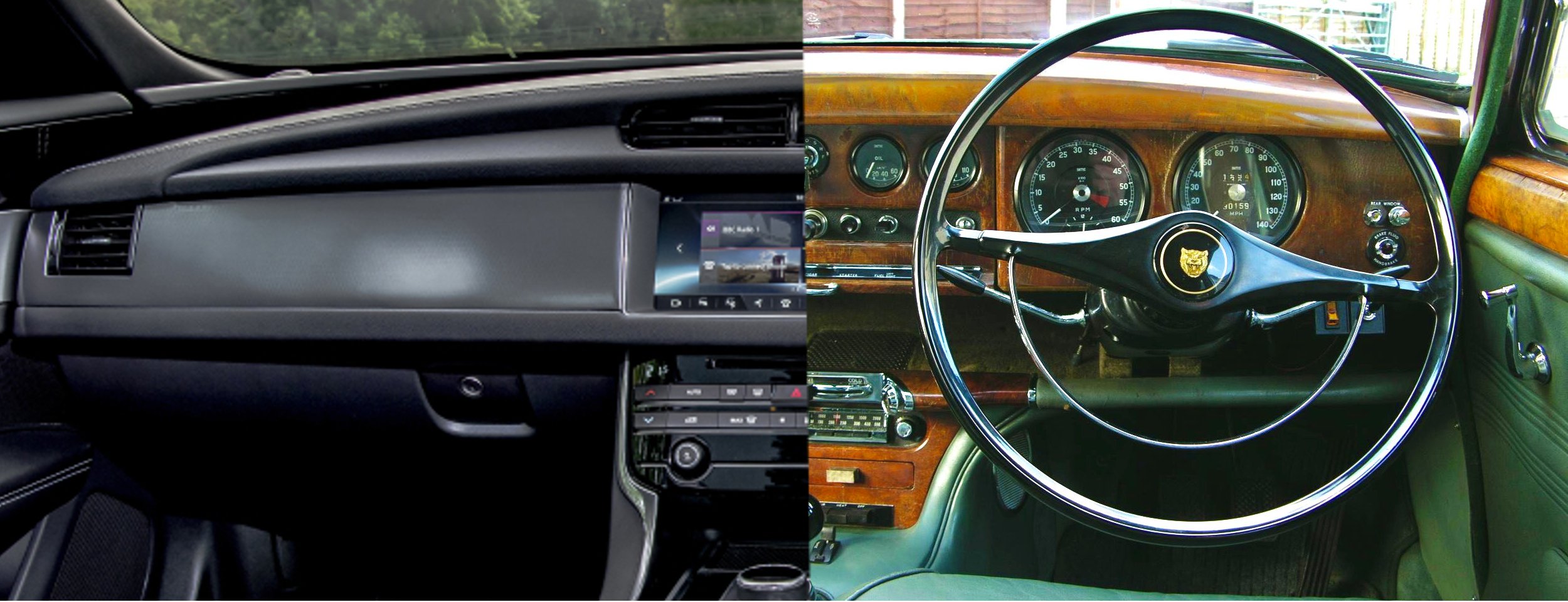Interior Evolution: Jaguar Mk2 - XF
Taking a look inside Jaguar’s executive car models over the years
This article is part of a DFT series focusing on the subject of interior design.
No car maker better illustrates the chasm between the actual importance of interior design and its public acknowledgement than Jaguar.
Sleek, athletic, elegant silhouettes are depicted in those images most readily associated with Jaguar. Cosy, (mostly) luxuriously appointed leather-and-walnut cabins only come up later - despite being no mere facet, but an integral part of the Jaguar marque’s allure.
In brief, the Jaguar ideal is an elegantly athletic looking automobile that strikes a paradoxical balance between performance and comfort, while cocooning driver and passenger inside a snug environment of traditional opulence. Jaguar’s core model, the XJ, never dramatically deviated from the latter part of this formula - not even in its final 2010-vintage iteration, whose cabin was distinctly more successful an update of the brand’s values than its striking, yet misguided exterior.
Far more representative of the Jaguar marque’s historical meanderings are its executive car interiors over the years. The initial 2.4/3.4 Litre models’ exteriors marked the first time a Jaguar saloon completely emancipated itself from the ‘Baby Bentley’ style template. The interior, by contrast, kept the established aesthetic of a most traditionally British luxury motor car, being entirely made of leather and walnut wood, with just a bit of bakelite and stainless steel garnish here and there.
This cabin’s ergonomics were rudimentary - but then as today, this remains a most indulgent, cosseting ambience that isn’t so much about making sense, but appealing to all senses. The saloon’s updated Mark 2 version hence strictly stuck with this formula of overwhelming visual lushness - which indeed was closer to a Bentley’s interior than any offered by those competitors even remotely within Jaguar’s price bracket.
In contrast to Jaguar’s progressive exterior design, this deeply traditional design approach was retained for all the marque’s saloon models henceforth - until the Mark 2’s ‘spiritual successor’, the S-type’s launch, more than three decades later.
Among the many symbols for Ford’s crude management of the Jaguar brand, the S-type’s initial interior design ranks very high indeed. Whereas earlier ‘90s Jaguar cabins had already pandered to American tastes, with regards to colour and trim choices in particular, the S-type’s interior made no serious attempt to tie in with the marque’s traditions whatsoever. Lip service was paid, courtesy of some wood trim placed in undiscerning fashion that could just as well have been taken from a high-spec Ford Taurus - but other than this, the S-type’s ambience was hardly different from a contemporary American or Japanese mid-range model.
So blatant were the deficiencies of this interior that S-type received an all-new dashboard within a few years into its production run. This was perfectly aligned with the T-shaped design already implemented in all other Jaguar models at the time and hardly the last word in terms of perceived quality - certainly not at a time when Audi was already pushing boundaries in this field -, but at least its brand of country club flair could immediately be placed in Warwickshire, rather than Wisconsin.
With not just S-type, but the Jaguar brand in its entirety having ended up in a retro design cul-de-sac by the early 2000s, it was up to its XF successor to achieve no less than a reinvention of Jaguar aesthetics and flair, inside and out, courtesy of new creative leadership.
Instead of trying to emulate the tradition of luxurious craftsmanship of classic Jaguar interiors, as the later S-type had done to moderate success, XF’s cabin was about creating a more clinical, contemporary upmarket flair - more W Hotel executive room than a suite at The Ritz, so to speak. Indeed, much of the cosiness and any impression of hand-made craftsmanship were lost, but with its swivelling air vents, rising gear selector and vodka lounge lighting, the XF cabin certainly was distinctive and did create a certain ‘sense of occasion’. As reinventions of core design aspects go, it can hence be considered a qualified success, even though any attempt at comparing XF’s interior with a contemporary Bentley’s would inevitably illustrate that the days of Jaguar offering Saville Row flair at Debenham’s prices were well and truly over.
Perplexingly, the second-generation XF’s interior didn’t build upon its predecessor’s strengths. Instead, Ford’s mistakes from 15 years earlier were repeated with astounding precision: With its utterly unstimulating ambience, serviceable ergonomics and dull appearance overshadowed by shockingly low levels of perceived quality, the X260-generation’s cabin possessed all the allure of Novotel accommodations. Clearly, even those executives who’d signed off S-type in its original form had ever so slightly better a grasp of the Jaguar brand’s values than those industry professionals who believed this miserable environment could lure anyone out of their BMW, Audi or Mercedes company car. The second generation XF’s cabin’s place in the annals of automotive design is hence assured - as an ode to corporate ignorance.
Not only Jaguar enthusiasts, but all those aforementioned BMW, Audi and Mercedes drivers unsurprisingly withstood this plasticky temptation, prompting a significant overhaul of the cabin design once the XF was in line for a facelift. The result, while unquestionably immensely superior, is in no way exceptional - and clearly too little, too late for a brand that has lost any relevance and meaning, for the time being.
By this point, to try and repeat history would be folly, of course - yet to ignore it outright negligence. For Jaguar to have any meaning again, a close look at those cosy, luxurious, handmade interior would be an inevitable step. Not in order to replicate them, but in order to understand how these make one feel - and how Jaguar, as passion-driven a marque as they come, can stir up emotions once again.



















Car interior designer who created some of the most significant cabins of all time, most notably the Porsche 928’s